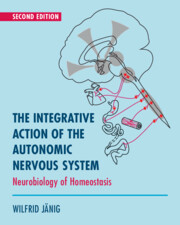Book contents
- The Integrative Action of the Autonomic Nervous System
- Reviews
- The Integrative Action of the Autonomic Nervous System
- Copyright page
- Dedication
- Contents
- Foreword to the Second Edition
- Foreword to the First Edition
- Preface
- Abbreviations
- Introduction The Autonomic Nervous System and the Regulation of Body Functions
- Part I The Autonomic Nervous System: Functional Anatomy and Interoceptive Afferents
- Part II Functional Organization of the Peripheral Autonomic Nervous System
- Chapter 3 The Final Autonomic Pathway and its Analysis
- Chapter 4 The Peripheral Sympathetic and Parasympathetic Pathways
- Chapter 5 The Enteric Nervous System
- Part III Transmission of Signals in the Peripheral Autonomic Nervous System
- Part IV Representation of the Autonomic Nervous System in the Spinal Cord and Lower Brain Stem
- Part V The Centers of Homeostasis in the Mesencephalon and Hypothalamus and Their Telencephalic Control
- Index
- References
Chapter 5 - The Enteric Nervous System
from Part II - Functional Organization of the Peripheral Autonomic Nervous System
Published online by Cambridge University Press: 16 July 2022
- The Integrative Action of the Autonomic Nervous System
- Reviews
- The Integrative Action of the Autonomic Nervous System
- Copyright page
- Dedication
- Contents
- Foreword to the Second Edition
- Foreword to the First Edition
- Preface
- Abbreviations
- Introduction The Autonomic Nervous System and the Regulation of Body Functions
- Part I The Autonomic Nervous System: Functional Anatomy and Interoceptive Afferents
- Part II Functional Organization of the Peripheral Autonomic Nervous System
- Chapter 3 The Final Autonomic Pathway and its Analysis
- Chapter 4 The Peripheral Sympathetic and Parasympathetic Pathways
- Chapter 5 The Enteric Nervous System
- Part III Transmission of Signals in the Peripheral Autonomic Nervous System
- Part IV Representation of the Autonomic Nervous System in the Spinal Cord and Lower Brain Stem
- Part V The Centers of Homeostasis in the Mesencephalon and Hypothalamus and Their Telencephalic Control
- Index
- References
Summary
The enteric nervous system (ENS) is an autonomic nervous system in its own right. It can function independently of the central nervous system. The neurons of the ENS are located the ganglia of the myenteric or submucosal plexus and consist of intrinsic primary afferent neurons, interneurons and motor neurons innervating various effectors. The primary transmitter in most excitatory enteric neurons is acetylcholine. Inhibitory motor neurons use several cotransmitters. Afferent neurons, interneurons and motor neurons form reflex circuits that underlie the neural regulation of motility, secretion, reabsorption, local blood flow and in protective reactions of the gastrointestinal tract. Motility patterns are mainly directed by the myenteric plexus. The neural basis of peristalsis consists of the coordinated activation of ascending and descending reflex pathways. The circular muscles are additionally influenced by a descending inhibitory reflex pathways. Inhibitory and excitatory reflex circuits are organized and coordinated with pacemaker activity of the interstitial cells of Cajal (ICCs) to generate the different movement patterns. The networks of ICCs are also responsible for oral-aboral contraction. Neural regulation of fluid and electrolyte transport is controlled through the submucosal plexus. The brain modulates the functions of the ENS via the parasympathetic and sympathetic nervous systems.
Keywords
- Type
- Chapter
- Information
- The Integrative Action of the Autonomic Nervous SystemNeurobiology of Homeostasis, pp. 134 - 164Publisher: Cambridge University PressPrint publication year: 2022

